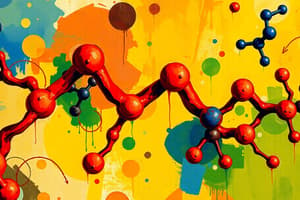Podcast
Questions and Answers
List the four major classes of macromolecules.
List the four major classes of macromolecules.
Carbohydrates, lipids, nucleic acids, and proteins.
Distinguish between monomers and polymers.
Distinguish between monomers and polymers.
Monomers are the building blocks of polymers, which are long chains of linked monomers.
What happens during a condensation reaction?
What happens during a condensation reaction?
Two molecules become covalently bonded with the loss of a small molecule, usually water.
Distinguish among monosaccharides, disaccharides, and polysaccharides.
Distinguish among monosaccharides, disaccharides, and polysaccharides.
Describe the formation of a glycosidic linkage.
Describe the formation of a glycosidic linkage.
What is the difference between the glycosidic linkages in starch and cellulose?
What is the difference between the glycosidic linkages in starch and cellulose?
Describe the role of symbiosis in cellulose digestion.
Describe the role of symbiosis in cellulose digestion.
Describe the biological importance of fats, phospholipids, and steroids.
Describe the biological importance of fats, phospholipids, and steroids.
Distinguish between saturated and unsaturated fats.
Distinguish between saturated and unsaturated fats.
Name the principal energy storage molecules of plants and animals.
Name the principal energy storage molecules of plants and animals.
Distinguish between a protein and a polypeptide.
Distinguish between a protein and a polypeptide.
Explain how a peptide bond forms between two amino acids.
Explain how a peptide bond forms between two amino acids.
List and describe the four major components of an amino acid.
List and describe the four major components of an amino acid.
What determines protein conformation?
What determines protein conformation?
How is the primary structure of a protein determined?
How is the primary structure of a protein determined?
Flashcards are hidden until you start studying
Study Notes
Classes of Macromolecules
- Four major classes: carbohydrates, lipids, nucleic acids, proteins.
Monomers vs Polymers
- Monomers: Basic building units of polymers.
- Polymers: Long molecules made of linked monomers.
Reactions: Condensation and Hydrolysis
- Condensation: Two molecules bond covalently, releasing water (dehydration reaction).
- Hydrolysis: Molecules are split by adding water, crucial for digestion.
Types of Carbohydrates
- Monosaccharides: Simplest carbohydrates; formula generally multiples of CH2O.
- Disaccharides: Two monosaccharides linked by dehydration synthesis.
- Polysaccharides: Long polymers of monosaccharides formed via dehydration synthesis.
Glycosidic Linkage Formation
- Forms between two monosaccharides during carbohydrate synthesis.
- Involves -C-OH groups, produces water, and results in -C-O-C- bond.
Glycosidic Linkages: Starch vs Cellulose
- Glucose can have two ring forms (α and β).
- Starch: Storage polysaccharide; Cellulose: Structural polysaccharide.
- Biologically important for energy storage and structure.
Symbiosis and Cellulose Digestion
- Herbivores rely on bacteria in their intestines to break down cellulose.
- Bacteria degrade cellulose, nourishing the herbivore; humans lack these bacteria for chitin.
Structure and Importance of Fats, Phospholipids, & Steroids
- Fats: Composed of glycerol and three fatty acids.
- Phospholipids: Form cell membranes; consist of glycerol and two fatty acids.
- Steroids: Include hormones and cholesterol; characterized by four fused rings.
Saturated vs Unsaturated Fats
- Saturated fats: No double bonds, solid at room temperature.
- Unsaturated fats: One or more double bonds, resulting in a liquid state at room temperature.
Energy Storage Molecules
- Plants store energy primarily as starch.
- Animals store energy as glycogen (synthesized in the liver).
Protein vs Polypeptide
- Proteins consist of one or more polypeptides folded into specific shapes.
Peptide Bond Formation
- Forms through dehydration reaction between the amino group of one amino acid and the carboxyl group of another.
Components of an Amino Acid
- Composed of amino group, carboxyl group, hydrogen atom, and variable R group.
- R group determines amino acid polarity and characteristics.
Protein Conformation Importance
- Protein conformation is influenced by environmental factors (temperature, pH).
- Denaturation occurs if conditions are unfavorable, leading to loss of function.
Primary Structure of Proteins
- Determined by DNA, specifying amino acid sequence bonded through peptide bonds.
Secondary Protein Structure and Interaction
- Two types: α-helix and β-pleated sheet.
- Hydrogen bonds stabilize secondary structures.
- Weak interactions and disulfide bridges contribute to tertiary structure stability.
Studying That Suits You
Use AI to generate personalized quizzes and flashcards to suit your learning preferences.




